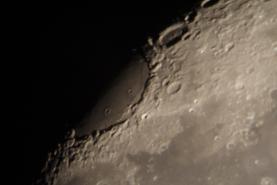|
|
The Moon
The Moon is the only
natural satellite of the
Earth, and the
fifth largest satellite in the
Solar System. It is the largest natural
satellite of a planet in the Solar System relative to the size of its
primary, having a quarter the diameter of Earth and 1⁄81 its
mass. The Moon is the
second densest satellite after
Io, a satellite of Jupiter. It is in
synchronous rotation with Earth, always
showing the same face; the
near side is marked with dark volcanic
maria among the
bright ancient crustal highlands and prominent
impact craters. It is the brightest
object in the sky after the Sun,
although its surface is actually very dark, with a similar reflectance to coal.
Its prominence in the sky and its regular cycle of
phases have,
since ancient times, made the Moon an important cultural influence on
language,
calendars,
art and
mythology. The Moon's gravitational
influence produces the
ocean tides and
the
minute lengthening of the day. The
Moon's current orbital distance, about thirty times the diameter of the Earth,
causes it to appear almost the same size in the sky as the Sun, allowing it to
cover the Sun nearly precisely in total
solar eclipses.
The Moon is the only
celestial body on which
humans have set foot. While the
Soviet Union's
Luna programme was the first to reach
the Moon with unmanned
spacecraft in 1959, the United States'
NASA
Apollo program achieved the only manned
missions to date, beginning with the first manned lunar orbiting mission by
Apollo 8 in 1968,
and six manned lunar landings between 1969 and 1972, with the first being
Apollo 11. These
missions returned over 380 kg of
lunar rocks, which
have been used to develop a detailed geological understanding of the Moon's
origins (it is thought to have formed some 4.5 billion years ago in
a giant impact event involving Earth),
the formation of
its internal structure, and
its subsequent history.
After the
Apollo 17 mission in 1972, the Moon has
been visited only by unmanned spacecraft, notably by the final
Soviet Lunokhod
rover. Since 2004, Japan, China, India,
the United States, and the
European Space Agency have each sent
lunar orbiters. These spacecraft have contributed to confirming the discovery of
lunar water ice in permanently shadowed
craters at the poles and bound into the lunar
regolith. Future
manned missions to the Moon have been planned, including government as well as
privately funded efforts. The Moon remains, under the
Outer Space Treaty, free to all nations
to explore for peaceful purposes.
Images from this page were published in the
Sky & Telescope Magazine's Photo Gallery.
Click on images for high resolution (opens new browser)
 |
|
Taken on 4/17/2008
Modified Canon Rebel XT 350D
Orion ED80
Single Exposure 1/1000
ISO 400
Focused with DSLRFocus
Processed with PhotoShop CS |

Mare Crisium (Sea of Crises)
|
|
Taken on 8/1/2007
Unmodified
Canon Rebel XT 350D
Orion ED80
Single exposure 0.3 seconds
ISO 800
Mare Crisium (the "sea of crises") is a
lunar mare located in the Moon's Crisium
basin, just northeast of
Mare Tranquillitatis. This basin is of the
Nectarian
epoch, while the mare material is of the
Upper Imbrian epoch. This mare is 376 miles
(605 KM) in diameter, with many notable features in and around it.
The cape-like feature protruding into the southeast of the mare is
Promonitorium Agarum. On the western rim of the mare is the
palimpsest
Yerkes. The
crater
Picard is located
just to the east of Yerkes, and northwest of Picard is the crater
Peirce.
[*]
|

|
|
Lunar Eclipse of March 3, 2007. No filters used. |
 |
|
March 27, 2007
Photo taken with an Unmodified Canon RebelXT 300mm zoom lens, f/5.6 on a fixed tripod. |
|
|